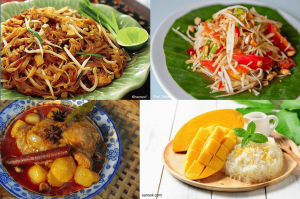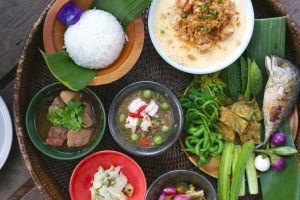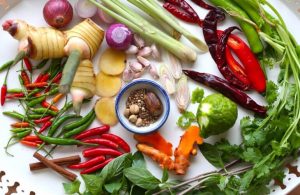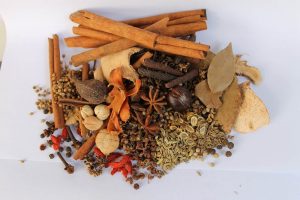Thai food is a symphony of senses and flavors. As a land of plenty, Thailand has inherited a cuisine rich in culture and variety. Local essences blend seamlessly with global flavors through trade and migration. The results of which are dishes steeped in diversity, from the royal dining hall to family tables. With the emergence of modern lifestyle, Thai culinary tradition has also transitioned into the realm of street cuisine without losing the spirit of detailed finesse. As such, Thailand is considered to be a leading figure in street food and modern dining culture. Today, Thai food is known far and wide, with generations of cooks continuing to preserve and built upon the Thai culinary heritage.

Familial Origins
Thai people first developed cooking skills as a way to express love and care within the family. Samrap (สำรับ) or set meals is a culinary tradition practiced by Thai families since ancient times. The staple of the Thai people is rice, which is consumed in conjunction with dishes called kap khao (กับข้าว) – literally; with rice. With many generations living under the same roof, the family cook must be able to produce a variety of kap khaos to suite all members of the household. Less flavored, easy-to-consume dishes are suitable for children. Fully-flavored, textured dishes are suitable for people in their prime age. Soft-textured, stomach-calming dished are suitable for the elderly. When a family member falls sick, herbal ingredients are often added to the menu, leading to the use of aromatics in many dishes. With a variety of dishes being served comes the practice of flavor blending. When a spicy dish is served, for example, a sweet dish is also served to counter the heat. Eventually, this practice became the origin of Thai food’s signature harmony of tastes.

Home-style meal [Post Today]
Five Senses and Eight Flavors
The backbone of Thai food rests on the harmonious combination of senses and flavors.
The five senses of Thai cuisine include:
- Visual (รูป): Thai dishes must be visually pleasing, with thought and process put into presentation.
- Taste (รส): Thai taste consists of eight flavors, which are always blended harmoniously.
- Aroma (กลิ่น): The aroma of Thai dishes derives from natural, herbal ingredients. Aromatics used in Thai cooking are often strong. Thus, it takes a great amount of skills to balance aromatic ingredients without overpowering the taste.
- Color (สี): Like the lively Thai people, the colors in Thai cuisine are vibrant and are derived from natural ingredients.
- Texture (สัมผัส): Each ingredient possesses its own texture. When combined together these textures must complement each other. The cook must also know methods to change the textures of ingredients when needed.
The essence of Thai tastes consists of eight flavors, including:
- Sourness (เปรี้ยว): found in ingredients such as lime and tamarind
- Saltiness (เค็ม): found in ingredients such as salt and fish sauce
- Sweetness (หวาน): found in ingredients such as sugar and coconut water
- Spiciness (เผ็ด): found in ingredients such as chili and pepper
- Creaminess (มัน): found in ingredients such as coconut milk and peanuts
- Bitterness (ขม): found in ingredients such as bitter gourd and neem shoots
- Acerbity (ฝาด): found in ingredients such as raw banana and raw eggplant
- Diffuseness (ฉุน): found in ingredients such as kaffir lime peel and cilantro
Spices and Aromatics
One crucial factor that contributes to the iconic balanced taste of Thai food is the masterful use of spices and aromatics. These ingredients are used in a variety of fashion, from garnishing (such as the use of cilantro to top fried rice), complimenting (such as the use of raw garlic to counterbalance oily menus), to direct infusion (such as the incorporation of kaffir lime leaves, galangal, and lemon grass in tom yum soup). One common method of cooking is to grind the components into a paste – called prik gaeng (พริกแกง), khrueng gaeng (เครื่องแกง), or simply khrueng (เครื่อง) – and use said paste as a base for soup, curry, and stir-fry, or even as a marinade.
The compendium of spices and aromatics used in Thai cooking reflect both local herbal knowledge as well foreign influences. Ingredients can be divided into two categories, which are often used jointly.
- Fresh Herbs and Aromatics: contain natural essential oils that give off distinct scents and flavors. They are, thus, best utilized in a state of freshness. Examples of this type of ingredients include galangal, lemongrass, kaffir lime peel and leaf, ginger, garlic, and fresh chili, among others.

[Locolise Asia]
- Dried Spices and Aromatics called khrueng tes (เครื่องเทศ) – foreign spices – in Thai: are dehydrated before being used for cooking. The reason for this is twofolds. First, some ingredients express different flavors when in a dried state versus a fresh state. A good example are the peppercorns, which become more hot and pungent when dried. Second, many of these ingredients were historically imported from overseas, hence the name foreign spices. This meant that they had to be dried to preserve them throughout long ship voyages. Examples include cumin (which came to Thailand from India) and nutmeg (which came to Thailand from Indonesia), among others.

[herbs-in-manman.blogspot.cpm]
Sources:
- “The Symphony of Thai Taste” by Chef Chumpol Jangprai: https://thaiembdc.org/2019/11/12/symphony-of-thai-tastes/
- “Thai Gastronomy from Home Kitchen to Royal Cuisine” By Kukanya Sujachaya (2018)
- “Thai Food: Thai Culture Heritage”, Department of Cultural Promotion, Ministry of Culture http://book.culture.go.th/thaifood/mobile/index.html#p=1
Written by: Tayud Mongkolrat


